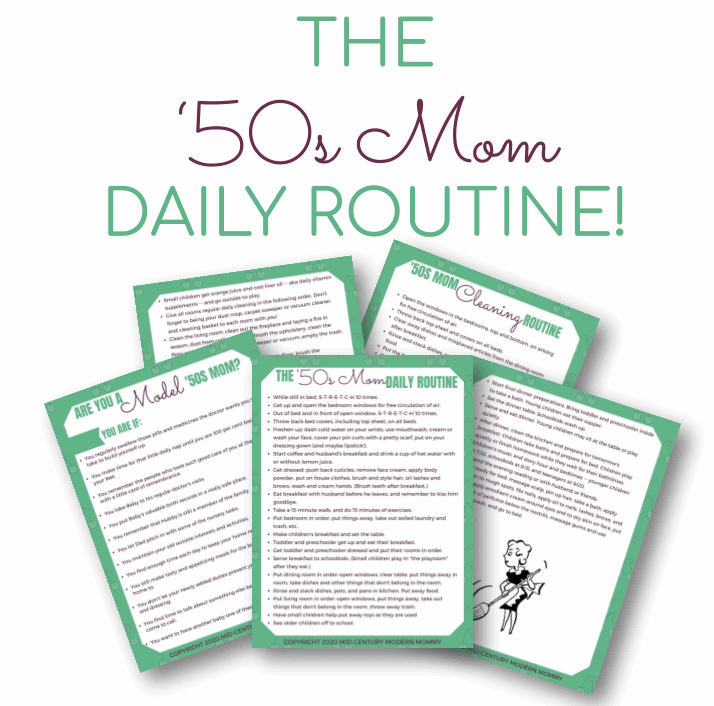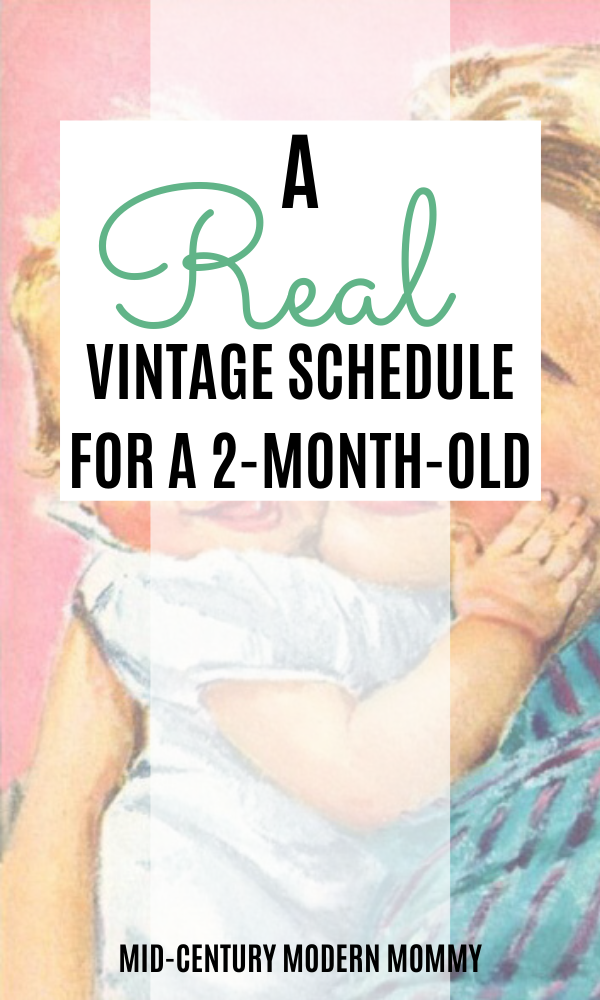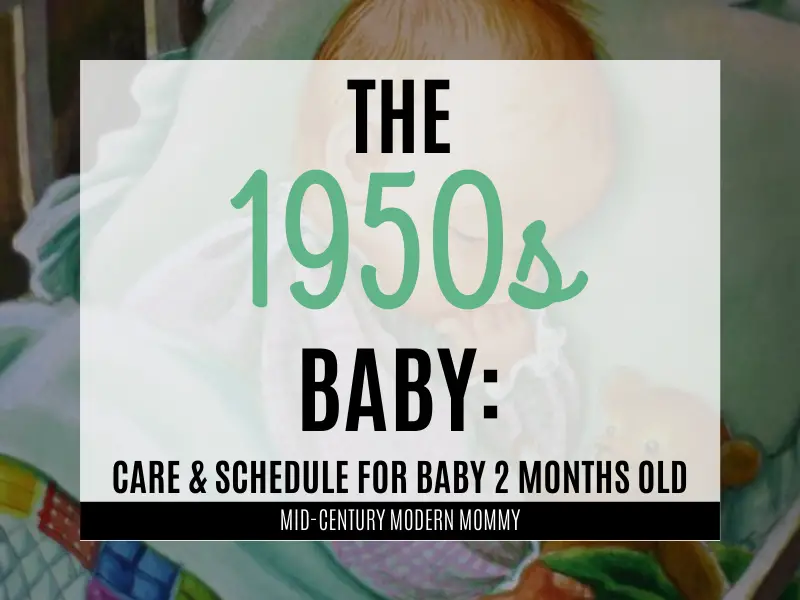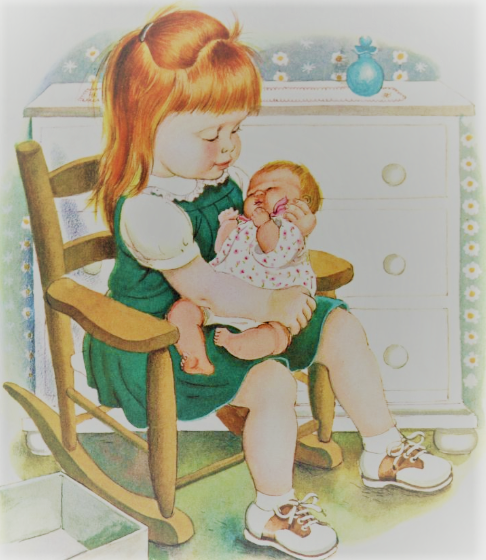Baby #8 is two months old already (heavens above, how time flies)! As we move through his first couple of years, I will continue posting about vintage baby care and schedules. For now, his schedule shifts a little bit each month. I have scooched him to a 4-hour feeding schedule, and next, we will be dropping the 2 am feeding. Anyway, here is how I use real 1950s Baby advice for care and schedule for a two-month-old.

Get Our Mid-Century Mom Daily Routine FREE!
Vintage Care Of The 2-Month-Old
This post contains affiliate links. If you click a link and make a purchase, I may receive, at no additional cost to you, a small commission. Find out more on my Disclosures page, and thank you so much for your support!
The Better Homes and Gardens Baby Book (affiliate link) says that a 2-month-old is beginning to be awake longer, hold his head up, and try to look toward light and sound. It also says that your baby should be between 2 and 4 pounds over his birth weight.

Feeding
At this point, your baby should be taking 5 FULL milk feedings. The book talks about dropping the 2 am feeding, and notes that if your baby isn’t ready to drop it, he isn’t getting enough during the day. (I usually increase pumping (affiliate link) at 2 months to make sure that I am keeping up my milk supply.) The schedule says to drop the 2 am feeding around 6-7 weeks, so at this point, the baby is being fed at 6 am, 10 am, 2 pm, 6 pm, and 10 pm.
Hygiene
The book also says that at this point, you can switch from sponge baths to tub baths, if you haven’t already. Wash his hair three times a week. Treat cradle cap with oil every night. (Affiliate links)
It also discusses bowel training. Apparently, some experts recommended waiting, but many mothers began training now. The case for starting early was that ever-so-1950s obsession with “regularity.” Quite honestly, I don’t potty-train at all until much later. But the book does suggest a marvelous method of potty-training which I do use!
The book recommends that the Baby take regular sunbaths in suitable weather. Starting at 2 minutes front and back a day, increase one more minute a day up to 20 minutes front and back. And shield his eyes. It also says don’t put him in the direct sun if the sun feels hot to you. But it does say that he should get his first sunburn sometime in the spring!
Sleep
In addition to the sleep training that happens with full feedings and a regular schedule, the book recommends teaching him to sleep on his face as soon as he can lift up his head. I don’t do this (also, it’s a risk for SIDS). I swaddle my babies until they start rolling over, so I put them down on their backs, swaddled for all their naps and quiet time.
Likewise, I don’t use sleeping bags until they aren’t in swaddles any more. But after that, I make seasonal sleeping bags so that they cannot kick their covers off.
Discipline
Fundamentally, discipline begins at birth. Discipline is simply training the child to live in the world as a part of society. Discipline is learning that he will be fed when he is hungry, and that bathtime comes at a certain time each day. It is also learning that he must take his cod-liver oil (affiliate link)and his orange juice (vintage vitamins!) every day.
Adhering to your routine and giving him your attention and loving care when he needs it is all the discipline that he needs at this age. He is learning that all of his needs are met in this strange new world and that he is loved. Consistency is the most important part of discipline.
The book also reminds us that our babies are unlike anyone else’s babies, and although most of the suggestions will work, some must be altered for our unique homes, families, and babies. Fit the schedule to Baby’s eating and sleeping habits and the family’s usual hours.
Also, the book suggests that you don’t take him away from home (except to the doctor) before the third month. Give him 3 months of regularity and quiet to grow on.
A REAL Vintage Schedule for Baby Two Months Old
This schedule contains affiliate links.
- 6:00 a.m. to 7:00 a.m. Feeding. Afterward, Baby may lie in his bassinet in the living room and may or may not nap.
- 9:00 a.m. Wheel into the bedroom for a short nap.
- 9:30 a.m. Vitamin D concentrate or 1 teaspoon fish-liver oil as prescribed. Two to three ounces of orange juice.
- 10:00 a.m. Bath, followed by feeding.
- 10:30 a.m. Sunbath on the porch or before an open window. Then Baby sleeps, either on the porch or indoors, depending on the weather.
- 1:30 p.m. to 2:00 p.m. Feeding. Baby will probably nap after this.
- 4:00 p.m. Outdoors on the porch, in the bassinet, or in the buggy.
- 5:00 p.m. Exercise on the big bed.
- 5:30 p.m. Baby can be held or carried about the house.
- 6:00 p.m. Feeding, followed by bed.
- 10:00 p.m. Feeding
Baby sleeps less as he gets older. This is to be expected. But opportunity should be given a baby of this age to get a nap before his bath, after the 10 o’clock feeding, and after the early afternoon feeding.
Caring for YOUR 2-Month-Old
Caring for a new baby is hard. It’s even harder when you have more than one child (there have NOT been 3 months of quiet at my house!) or baby blues. A schedule is the biggest help in being able to be a housewife, a mother, a wife, and still be YOU. And you don’t have to stick to a schedule like glue. If you get to the end of the scheduled time, move on to the next thing. Nothing will ever be perfect, but you’ll come back to it tomorrow and start again. Eventually, you’ll be able to accomplish all the things in your schedule, on time. Then, you’ll start wondering exactly WHEN you became so good at this!




